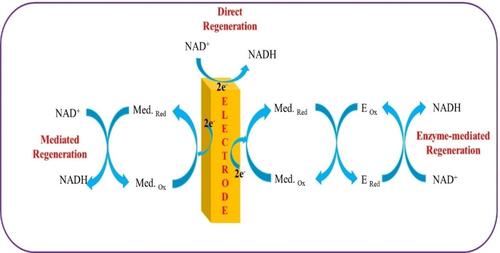当前位置:
X-MOL 学术
›
Chem. Asian J.
›
论文详情
Our official English website, www.x-mol.net, welcomes your
feedback! (Note: you will need to create a separate account there.)
Recent Progress and Perspectives on Electrochemical Regeneration of Reduced Nicotinamide Adenine Dinucleotide (NADH)
Chemistry - An Asian Journal ( IF 3.5 ) Pub Date : 2020-11-08 , DOI: 10.1002/asia.202001035 Susan Immanuel 1 , R. Sivasubramanian 1 , Rukhsana Gul 2 , Mushtaq Ahmad Dar 3
Chemistry - An Asian Journal ( IF 3.5 ) Pub Date : 2020-11-08 , DOI: 10.1002/asia.202001035 Susan Immanuel 1 , R. Sivasubramanian 1 , Rukhsana Gul 2 , Mushtaq Ahmad Dar 3
Affiliation

|
NAD is a cofactor that maintains cellular redox homeostasis and has immense industrial and biological significance. It acts as an enzymatic mediator in several biocatalytic electrochemical reactions and undergoes oxidation/reduction to form NAD+ or NADH, respectively. The NAD redox couple (NAD+/NADH) mostly exists in enzyme‐assisted metabolic reactions as a coenzyme during which electrons and protons are transferred. NADH shuttles these charges between the enzyme and the substrate. In order to understand such complex metabolic reactions, it is vital to study the bio‐electrochemistry of NADH. In addition, the regeneration of NADH in industries has attracted significant attention due to its vast usage and high cost. To make biocatalysis economically viable, primary methods of NADH regeneration including enzymatic, chemical, photochemical and electrochemical methods are widely used. This review is mainly focused on the electrochemical reduction of NAD+ to NADH with specific details on the mechanism and kinetics of the reaction. It provides emphasis on the different routes (direct and mediated) to electrochemically regenerate NADH from NAD+ highlighting the NAD dimer formation. Also, it describes the electrocatalysts developed until now and the scope for development in this area of research.
中文翻译:

还原烟酰胺腺嘌呤二核苷酸(NADH)电化学再生的最新进展和展望
NAD是维持细胞氧化还原稳态的辅因子,具有巨大的工业和生物学意义。它在几种生物催化电化学反应中充当酶介体,并经过氧化/还原分别形成NAD +或NADH。NAD氧化还原对(NAD +/ NADH)大多作为酶在电子辅助的质子转移过程中的辅助酶而存在。NADH使这些电荷在酶和底物之间穿梭。为了了解这种复杂的代谢反应,研究NADH的生物电化学至关重要。另外,由于NADH的广泛使用和高成本,其在工业中的再生引起了广泛的关注。为了使生物催化经济可行,广泛使用了NADH再生的主要方法,包括酶促,化学,光化学和电化学方法。这篇综述主要侧重于NAD +的电化学还原NADH的详细信息,包括反应机理和动力学。它着重于从NAD电化学再生NADH的不同途径(直接途径和介导途径)+突出了NAD二聚体的形成。此外,它描述了迄今为止开发的电催化剂以及该研究领域的发展范围。
更新日期:2020-12-16
中文翻译:

还原烟酰胺腺嘌呤二核苷酸(NADH)电化学再生的最新进展和展望
NAD是维持细胞氧化还原稳态的辅因子,具有巨大的工业和生物学意义。它在几种生物催化电化学反应中充当酶介体,并经过氧化/还原分别形成NAD +或NADH。NAD氧化还原对(NAD +/ NADH)大多作为酶在电子辅助的质子转移过程中的辅助酶而存在。NADH使这些电荷在酶和底物之间穿梭。为了了解这种复杂的代谢反应,研究NADH的生物电化学至关重要。另外,由于NADH的广泛使用和高成本,其在工业中的再生引起了广泛的关注。为了使生物催化经济可行,广泛使用了NADH再生的主要方法,包括酶促,化学,光化学和电化学方法。这篇综述主要侧重于NAD +的电化学还原NADH的详细信息,包括反应机理和动力学。它着重于从NAD电化学再生NADH的不同途径(直接途径和介导途径)+突出了NAD二聚体的形成。此外,它描述了迄今为止开发的电催化剂以及该研究领域的发展范围。











































 京公网安备 11010802027423号
京公网安备 11010802027423号